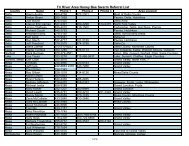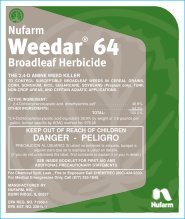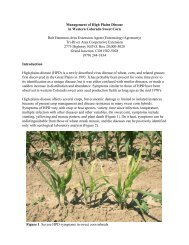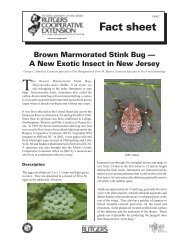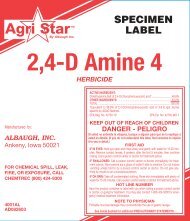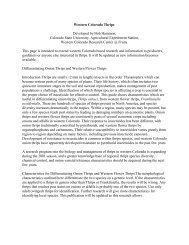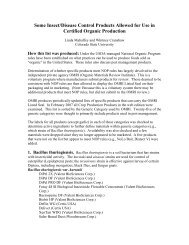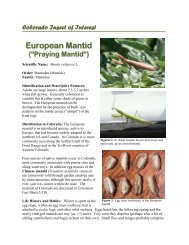UT fact sheet - Western Colorado Insects
UT fact sheet - Western Colorado Insects
UT fact sheet - Western Colorado Insects
You also want an ePaper? Increase the reach of your titles
YUMPU automatically turns print PDFs into web optimized ePapers that Google loves.
Published by Utah State University Extension and Utah Plant Pest Diagnostic Laboratory ENT-140-10 September 2010<br />
Spotted Wing Drosophila<br />
Ryan S. Davis, Arthropod Diagnostician, Diane Alston, Entomologist, and Cory Vorel, CAPS Coordinator<br />
WHAT YOU SHOULD KNOW<br />
• Spotted Wing Drosophila (SWD) is a new Utah pest (first found August,<br />
2010) that can infest un-ripened (pre-harvest), ripe, over-ripe, and<br />
spoiled fruits.<br />
• SWD attacks a broad range of fruits, including tree fruits, berry fruits, and<br />
vegetable fruits.<br />
• SWD can be easily controlled using standard insecticides, and by<br />
expanding the spray program to pre- and post-ripe fruit stages.<br />
• Suspect SWD flies should be sent to the Utah Plant Pest Diagnostic Lab<br />
(UPPDL) for identification.<br />
BACKGROUND<br />
Spotted Wing Drosophila (SWD) (Drosophila suzukii) is a new fruit pest<br />
recently discovered in Davis County, Utah(August, 2010). Because this pest<br />
is widespread in the western and southeastern United States, it is considered<br />
“non-actionable,” meaning no import or export restrictions, or quarantines<br />
will be implemented. SWD is similar to other vinegar flies (genus Drosophila),<br />
except they can infest unripe fruit. SWD can be easily controlled using<br />
insecticides common in fruit integrated pest management plans. If SWD is<br />
caught in monitoring traps, insecticide applications must be used during the<br />
unripe fruit stage to prevent damage.<br />
Scientific Name: Drosophila suzukii (Drosophillidae)<br />
Range in U.S.: Davis County, Utah; California; Oregon;<br />
Washington, Florida, Louisiana, North Carolina, and South<br />
Carolina.<br />
Hosts: Detected in a raspberry and blackberry field in<br />
Kaysville, Utah (trap survey). Hosts include: tree fruits<br />
(apple, apricot, cherry, mullberry, nectarine, peach,<br />
persimmons, plum, pluot); small fruits (blackberry,<br />
blueberry, grapes, raspberry, strawberry); vegetable<br />
fruits (melons, tomato). Any soft-skinned fruit may be<br />
susceptible to SWD.<br />
Damaging Stage: Larvae and adults. Larvae feed inside<br />
fruit causing abscesses; secondary fungal and pest<br />
infection may occur. Adults cause superficial scarring by<br />
sawing into fruit to lay eggs.<br />
Overwintering Stage: Unknown if SWD will survive winter<br />
in northern Utah; survival in southern Utah is likely. Adults<br />
and pupae may overwinter.<br />
BIOLOGY<br />
Fig. 1. Adult male spotted wing drosophila (Drosophila<br />
suzukii.). Photo by G. Arakelian.<br />
This <strong>fact</strong> <strong>sheet</strong> describes SWD biology and current monitoring and control strategies for growers and homeowners.<br />
Any suspect SWD should be sent to the UPPDL for identification. Many flies have spots on their wings. Small flies with only 1<br />
spot per wing (Fig. 1) should be considered suspect.<br />
Egg: Small, white, inserted into fruit. Two thin filaments<br />
used for breathing are visible protruding out of fruit. Over<br />
350 eggs may be laid by a single female (Fig. 2).<br />
Immature: Small (0.067-3.5mm or 0.003-.01in) creamcolored<br />
maggot with black mouthparts (Fig. 3).<br />
Adult: Typical vinegar fly appearance: 2-3 mm (0.1 in)<br />
long, red eyes, pale brown body, featherlike antennae.<br />
Males have one circular black spot per wing (Fig. 1);<br />
females have no spots on wings and a sawlike ovipositor<br />
(Fig. 2). They are most active at 68 o F; egg laying<br />
decreases above 86 o F.<br />
Pupae: Small (2-3 mm or 0.1 in) brown, cylindrical<br />
capsules with two extensions on one end (Fig. 4). Found<br />
in fruit or just below leaf litter in soil.<br />
Generations per year: Unknown for Utah. Three to eight<br />
gen/yr have been observed in Oregon, and 10-13 gen/yr<br />
in California.
Figs. 2, 3, and 4. Left to right: Spotted wing drosophila (SWD) serrated ovipositor and egg (photo insert by Steve Valley); SWD larva; SWD<br />
pupa. Photos by E. Beers.<br />
Seasonal Emergence: Unknown for Utah. Washington<br />
State University estimates SWD emergence between late<br />
May and early June (514 degree days o F, base temp.<br />
48 o F).<br />
Important Behaviors: Can lay eggs in unripe, ripe,<br />
overripe, shriveled, or spoiled fruit. Adults prefer to feed<br />
on damaged or fermenting fruit.<br />
MONITORING METHODS<br />
Control is not recommended unless SWD is caught in<br />
monitoring traps, fruit injury is detected, or a high-value<br />
crop needs protecting. The following traps can be used<br />
for monitoring:<br />
• Prepare bait and add to cup: mix 0.25 oz yeast (one<br />
package) + 4 teaspoons sugar + 12 fl oz water, or<br />
2-3” of apple cider vinegar as a substitute for the<br />
yeast mixture.<br />
• Add 1 to 2 drops of dish soap (optional, but will<br />
improve fly capture).<br />
• Attach lid.<br />
• Hang traps at fruit level. In low-growing fruits such as<br />
strawberries, sink traps 2-3” in the ground.<br />
Clear Cup Trap: For homeowners or low-budget growers,<br />
simple traps can be made from a 16 to 32 oz clear plastic<br />
cup and lid, hanger, bait solution, twist-tie or paper clip,<br />
and a yellow sticky card.<br />
• On one side of the cup, drill four to six, 3/16” holes in<br />
the upper portion of the cup.<br />
• Drill two holes on opposite sides of the cup to put<br />
hanger through (to hang trap).<br />
• Put yellow sticky card in cup by attaching to a twisttie<br />
put through two small holes in the top of the lid.<br />
Optional, but may make monitoring easier.<br />
Fig. 5. Homemade SWD cup trap. Flies attracted to the<br />
bait enter through the holes and land on the yellow<br />
sticky card or in the bait solution. Photos by BC Ministry<br />
of Agriculture and Lands.<br />
Fig. 6. Contech fruit fly trap (left), and McPhail trap (right).<br />
Commercially Available Traps: Easy-to-use commercial<br />
traps are available from Contech (Fruit Fly Trap) for about<br />
$10 for a two-pack (Fig. 6). McPhail traps from ISCA Tech.<br />
are more complex to use and cost about $14 per trap<br />
(available in bulk order rates at $11 each). There are<br />
many other similar traps on the market that work on the<br />
same principles. Homemade and commercial traps are<br />
equally effective at catching SWD. See “Trap Sources” at<br />
end of publication for contact information.<br />
Liquid Baits: The two best bait solutions to use in traps<br />
are apple cider vinegar, or a sugar-water-yeast solution.<br />
The yeast solution is likely a better attractant when SWD<br />
populations are low. If you are trapping to detect the<br />
presence of SWD, you may want to use the yeast solution.<br />
The downside of the yeast solution is that it needs to<br />
be changed at least every 2 weeks, is messy, and has<br />
a bad odor. Once a SWD population is confirmed,<br />
you can switch to the vinegar solution for monitoring.<br />
All liquid baits should be changed weekly for optimal<br />
performance.<br />
Page 2
Fruit Dunk: Developed at Oregon State University, this<br />
method of larva detection works best with smaller fruits,<br />
e.g., berries and cherries. Collect 50 to 75 randomly<br />
selected fruits (depending on the fruit size), and place<br />
them in a 1 gallon ziplock bag. Lightly crush fruit to<br />
expose larvae. Add 1 cup of a sugar solution (1/4 cup<br />
sugar to 4 cups water) and wait a few minutes. If present,<br />
larvae will float to the surface, while fruit will sink. The<br />
presence of larvae may indicate SWD in your fruit crop.<br />
There are other species of fruit-infesting insect larvae,<br />
such as cherry fruit fly, currant maggot and sap beetle.<br />
The UPPDL can assist with insect larva identification.<br />
NON-CHEMICAL CONTROL<br />
Non-chemical control begins with monitoring for SWD.<br />
The methods below are possible for both the homeowner<br />
and fruit grower, but are more feasible on a small scale.<br />
Baits/Traps: Use traps throughout and around fruit<br />
production areas to capture and kill adult flies.<br />
Sanitize: Damaged or fallen fruit should be removed from<br />
the property, buried, solarized, crushed, or stored in a<br />
sealed container to exclude flies. Remove neglected fruit<br />
orchards.<br />
Exclusion: Fine-mesh floating row covers can protect low<br />
growing fruits.<br />
Timeliness: Pick ripe fruits frequently to minimize potential<br />
SWD host material where populations may build.<br />
Freezing: Infested harvested fruit may be stored at 35 o F or<br />
lower for at least 96 hours to kill developing eggs, larvae,<br />
pupae, and adults.<br />
CHEMICAL CONTROL<br />
A SWD control program starts with monitoring.<br />
If SWD is detected, chemical control is necessary to<br />
preserve the marketability of fruit. For commercial<br />
growers, some chemicals already used in your IPM<br />
program for similar pests should give effective control<br />
of SWD. To protect fruit, an additional insecticide<br />
USEFUL SWD REFERENCES<br />
BC Ministry of Agriculture and Lands: http://www.al.gov.bc.ca/cropprot/swd.htm<br />
Google page on SWD: http://sites.google.com/site/spottedwingdrosophila/<br />
Kanzawa, T. 1939. Spotted Wing Drosophila Report.<br />
Oregon Department of Agriculture: http://www.oregon.gov/ODA/PLANT/IPPM/<br />
Oregon State University: http://swd.hort.oregonstate.edu/<br />
University of California: http://www.ipm.ucdavis.edu/EXOTIC/drosophila.html<br />
Univeristy of California SWD blog: http://ucanr.org/blogs/strawberries_caneberries/<br />
Washington State University: http://jenny.tfrec.wsu.edu/opm/displaySpecies.php?pn=165<br />
application will be needed at the pre-ripe (straw color)<br />
stage, with additional applications as per the label<br />
directions through harvest, and post-harvest if a high<br />
volume of fruit remains on trees or plants.<br />
Select insecticide products based on the fruit<br />
type you want to protect. Products that are effective<br />
against tephritid fruit flies will be effective against SWD.<br />
Products for commercial and homeowner (H) use,<br />
including organically certified (O) products, listed in<br />
Table 1, have shown good to excellent control of SWD<br />
in preliminary tests. Do not apply insecticides while<br />
pollinators are active.<br />
Product<br />
Name<br />
Active<br />
Ingredient<br />
MoA<br />
Asana esfenvalerate 3A<br />
Assail H acetamiprid 4A<br />
Baythroid H beta-cyfluthrin 3A<br />
Delegate H spinetoram 5<br />
Diazinon diazinon 1B<br />
Dimethoate dimethoate 1B<br />
Entrust H, O spinosad 5<br />
Guthion azinphos-methyl 1B<br />
Malathion H malathion 1B<br />
Pounce permethrin 3A<br />
Proaxis gamma-cyhalothrin 3A<br />
Provado H imidacloprid 4A<br />
Pyganic H, O pyrethrin 3A<br />
Sevin H carbaryl 1A<br />
Success H spinosad 5<br />
Warrior lambda-cyhalothrin 3A<br />
Table 1. Insecticides for SWD control. Products are not complete<br />
listings of all available options; H signifies that the product<br />
is registered for homeowner use, O signifies an organically<br />
compatible insecticide. Not all products are labeled on all<br />
fruits; read label to ensure that your product matches the site.<br />
Alternate the MoA (mode of action) of the product you choose<br />
on a yearly basis to minimize resistance build-up.<br />
Contech Enterprises Inc.<br />
Unit 115 - 19 Dallas Road<br />
Victoria, BC V8V 5A6<br />
Canada<br />
tel: 1-800-767-8658<br />
fax: 1-800-876-1666<br />
email: na<br />
website: www.contech-inc.<br />
com/<br />
TRAP SOURCES<br />
ISCA Technologies Inc.<br />
P.O. Box 5266<br />
Riverside, CA 92517<br />
United States of America<br />
tel: (951) 686-5008<br />
fax: (815) 346-1722<br />
email: info@iscatech.com<br />
website: www.iscatech.com<br />
Precautionary Statement: Utah State University Extension and its employees are not responsible for the use, misuse, or damage caused by application or misapplication of products or<br />
information mentioned in this document. All pesticides are labeled with ingredients, instructions, and risks, and not all are registered for edible crops. “Registered use” pesticides may<br />
only be applied by a licensed applicator. The pesticide applicator is legally responsible for proper use. USU makes no endorsement of the products listed herein.<br />
Utah State University is committed to providing an environment free from harassment and other forms of illegal discrimination based on race, color, religion, sex, national origin, age (40 and older), disability,<br />
and veteran’s status. USU’s policy also prohibits discrimination on the basis of sexual orientation in employment and academic related practices and decisions. Utah State University employees<br />
and students cannot, because of race, color, religion, sex, national origin, age, disability, or veteran’s status, refuse to hire; discharge; promote; demote; terminate; discriminate in compensation; or<br />
discriminate regarding terms, privileges, or conditions of employment, against any person otherwise qualified. Employees and students also cannot discriminate in the classroom, residence halls, or in<br />
on/off campus, USU-sponsored events and activities. This publication is issued in furtherance of Cooperative Extension work, acts of May 8 and June 30, 1914, in cooperation with the U.S. Dept. of Ag.,<br />
Noelle E. Cockett, Vice President for Extension and Agriculture, Utah State University.<br />
UPPDL, 5305 Old Main Hill, Logan <strong>UT</strong> 84322, utahpests.usu.edu T: 435.797.2435 F: 435.797.8197<br />
Page 3





